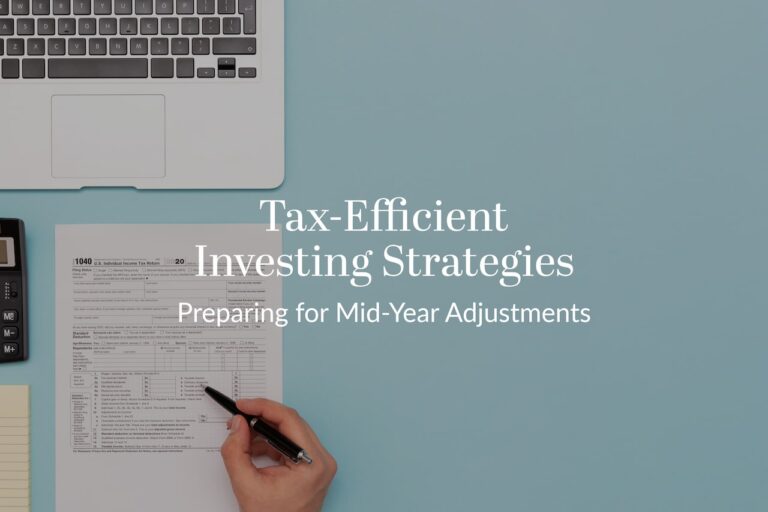How to use tax strategies for beneficial mid-year investment adjustments
Tax-efficient investing can help you optimize your portfolio through strategic investment choices, asset location, and thoughtful trading decisions. Taxes on investment gains, dividends, and interest income can significantly impact overall returns. Conducting mid-year investment adjustments allows you to reassess your strategy and make changes that could improve tax outcomes. Being mindful of how and where your investments are held—especially during these check-ins—can influence your long-term financial success.
Understanding Tax-Efficient Investing
Some of the main considerations for tax-efficient investing include capital gains taxes, tax-advantaged accounts, asset location strategies, and tax-loss harvesting. Reviewing these factors mid-year provides an opportunity to make necessary adjustments without the last-minute pressure of year-end tax planning.
1. Reviewing Asset Location Strategies
Different types of investments are taxed in different ways, making it important to consider where assets are held. Tax-efficient asset location strategies involve placing investments in accounts that align with their tax characteristics.
- Taxable accounts (brokerage accounts): Suitable for investments that receive favorable tax treatment, such as stocks held for long-term capital gains and tax-efficient exchange-traded funds (ETFs).
- Tax-advantaged accounts (IRAs, 401(k)s, and Roth accounts): Can be beneficial for investments that generate ordinary income, such as bonds, dividend-paying stocks, and actively managed funds.
- Health Savings Accounts (HSAs): Offer tax benefits for those who qualify, and can be used for medical expenses or long-term savings.
Mid-year investment adjustments allow you to assess whether your asset location aligns with tax considerations and make changes if needed.
2. Capital Gains Considerations and Holding Periods
If you buy and sell assets, you may face capital gains taxes, which vary depending on how long an asset has been held.
- Short-term capital gains apply to assets sold within one year and are taxed at ordinary income tax rates, which can be higher.
- Long-term capital gains apply to assets held for more than a year and are taxed at lower rates.
Reviewing portfolio holdings mid-year allows you to assess whether holding an asset longer could reduce capital gains taxes. If selling is necessary, understanding the tax impact ahead of time can help with decision-making.
3. Tax-Loss Harvesting Strategies
Tax-loss harvesting involves selling investments that have declined in value to offset capital gains elsewhere in a portfolio. This strategy can reduce taxable income while maintaining overall investment objectives.
- Offsetting gains: If an investor has realized capital gains earlier in the year, tax-loss harvesting can help reduce tax liability.
- Reinvesting proceeds: When selling a losing investment, reinvesting in a similar asset can keep the portfolio aligned with long-term goals while maintaining market exposure.
Since markets fluctuate throughout the year, mid-year is a good time to assess whether tax-loss harvesting opportunities exist. However, be mindful of the IRS wash-sale rule, which prohibits repurchasing the same or a substantially identical security within 30 days before or after a sale that is claimed for tax-loss purposes.
4. Managing Dividend and Interest Income
Dividends and interest income from investments can impact tax liability. Understanding how these income sources are taxed can help you make adjustments during the year.
- Qualified dividends are typically taxed at long-term capital gains rates, while non-qualified dividends are taxed at ordinary income rates.
- Bond interest income is generally taxed as ordinary income, though municipal bonds may offer tax advantages at the federal or state level.
If you want to manage your tax exposure, consider adjusting your holdings in taxable accounts or shifting dividend-producing investments to tax-advantaged accounts where applicable.
5. Contributions to Tax-Advantaged Accounts
Contributing to tax-advantaged accounts throughout the year can provide potential tax benefits. Mid-year is a good time to evaluate contributions, consider mid-year investment adjustments, and make changes that align with your financial goals.
- 401(k) and 403(b) plans: Contributing pre-tax dollars can lower taxable income. Checking contribution levels mid-year can help you stay on track.
- Traditional and Roth IRAs: Contributions to traditional IRAs may be tax-deductible, while Roth IRA contributions grow tax-free if eligibility requirements are met.
- Health Savings Accounts (HSAs): If eligible, contributing to an HSA can provide tax benefits while helping with healthcare costs.
Assessing contribution levels before the end of the year allows time for adjustments based on financial goals and tax planning considerations.
6. Charitable Giving and Tax Benefits
Charitable contributions can provide tax benefits for those who itemize deductions. The middle of the year is a good time to plan donations and explore tax-efficient giving strategies.
- Donating appreciated assets: You may consider donating appreciated stocks or other assets, which could potentially offer tax benefits by avoiding capital gains taxes.
- Qualified Charitable Distributions (QCDs): Individuals over a certain age with traditional IRAs may be able to make QCDs, which count toward required minimum distributions (RMDs) and can reduce taxable income.
Planning charitable contributions ahead of time allows for thoughtful decision-making and alignment with tax strategies.
7. Preparing for Required Minimum Distributions (RMDs)
For those with tax-deferred retirement accounts, required minimum distributions (RMDs) must be taken after reaching a certain age. Failing to withdraw the required amount can result in tax penalties.
Checking RMD requirements at mid-year can help you plan withdrawals in a way that aligns with your financial needs and tax considerations.
8. Reviewing Tax-Efficient Investment Vehicles
Some investments are structured to be more tax-efficient than others. Reviewing the types of funds and assets held in a portfolio can help manage tax implications.
- Index funds and ETFs tend to be more tax-efficient due to lower turnover, reducing taxable capital gains distributions.
- Tax-managed funds are designed to minimize taxable events for investors.
- Municipal bonds can provide federal (and sometimes state) tax advantages for those in higher tax brackets.
Evaluating investment choices mid-year provides an opportunity to adjust holdings based on tax considerations.
Taking a Mid-Year Approach to Tax Efficiency
By reviewing tax-efficient investment strategies during the year, you have time to make adjustments that align with your financial goals and tax considerations. Assessing asset location, capital gains exposure, tax-loss harvesting opportunities, and contributions to tax-advantaged accounts can help refine a portfolio’s tax efficiency before year-end deadlines approach.
Mid-year investment adjustments allow you to make proactive changes rather than waiting until the final months of the year. Taking time to review investments and tax strategies can help you create a more informed approach to managing taxes within your investment portfolio.
Illuminated Advisors is the original creator of the content shared herein. I have been granted a license in perpetuity to publish this article on my website’s blog and share its contents on social media platforms. I have no right to distribute the articles, or any other content provided to me, or my Firm, by Illuminated Advisors in a printed or otherwise non-digital format. I am not permitted to use the content provided to me or my firm by Illuminated Advisors in videos, audio publications, or in books of any kind.










